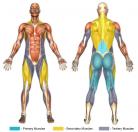Straight Leg Deadlifts (Barbell)
- Using an Olympic barbell, secure the desired amount of weight plates to the bar.
- Stand with the feet shoulder width apart and the toes pointed straight.
- Maintaining a slight bend in the knees, reach down and grab the bar (keeping the back straight and only bending at the waist) with a pronated grip (overhand). The point of grip should be slightly wider than shoulder width.
- Keeping the thighs stationary and the butt from dropping, lift the barbell up, exhaling throughout the motion. Be sure to not lock the knees once the peak of the lift occurs.
- Lower the weight back down being mindful to not arch the back. Inhale on the downward motion.
- The barbell should merely tap the ground before repeating steps 4-5.
When gripping the barbell, the butt will naturally stick out. During the lifting motion, it will be pulled into alignment with the rest of the body. The important thing to remember is that the butt should not drop down as if one is performing a squat. If this happens, the quadriceps become more involved.
Some points to keep in mind:
- If you aren't using wrist straps (wrist straps are fabric straps that allow for heavier lifting by reducing stress put on the fingers and forearms) but still want to keep your grip when lifting a heavier weight, you can alternate your grip (using an, aptly titled, "alternate grip" or "reverse power grip") so that one hand is overhand (palm facing you) and one is underhand (palm facing away). This grip method can also be used in conjunction with wrist straps to further increase the amount of weight that can be held. It's effective for primarily two reasons: one is that it keeps the bar from rolling and the other is that it aids the thumbs in keeping their grip better. The latter reason is explained by the fact that with both hands in an overhand grip there are 8 fingers on one side of the bar and only the 2 thumbs remaining on the other. Whereas, with one hand in an overhand grip and the other in an underhand grip there are 5 fingers on each side of the bar. Thus, the thumbs have help.
- The bar cannot be gripped too hard. The better your grip is the more power and control you will feel. Not to mention, a good grip is conducive to being able to focus on lift form and the muscles involved.
- Notice that proper breathing for this exercise is different than many others. The inhaled breath is held, while at the same time contracting the abdominal muscles (and lower back muscles, if possible - many people find conscious contraction of these muscles difficult), so that a body "block" is created. Below is a description of how to achieve a "block".
A "Block" or "Blocking":
Blocking is used to create a rigid core. A rigid core both improves strength and helps to prevent injury. It is best utilized and absolutely recommended whenever heavy weights are involved. The goal of blocking is to keep rounding of the back (vertebral flexion) at bay. There are 3 aspects to achieving a block. They are:
- Deeply inhale prior to the effort and hold this inhalation until the end of the effort. Deep inhalation causes chest expansion by filling the lungs with oxygen. This prevents the chest from collapsing forward when the body is being subjected to heavy weight-lifting.
- Contract the abdominal muscles throughout the effort. The increased intra-abdominal pressure enhances core support by essentially preventing the torso from collapsing forward.
- Contract the lumbar (lower back) muscles. This keeps a slight arch in the lower back. The point is to keep the spinal column in extension.
As with all exercises, over-arching or rounding of the back and lead to injury. This is especially true for straight leg deadlifts. With this being a power exercise, most individuals use a large amount of weight while performing them which increases the likelihood of injury if improper lifting technique is used.
Some may view straight leg deadlifts as an easier version of deadlifts. While the quadriceps are not targeted directly in straight leg deadlifts, the lifting motion is no less effective at targeting the hamstrings, buttocks and lower back.





